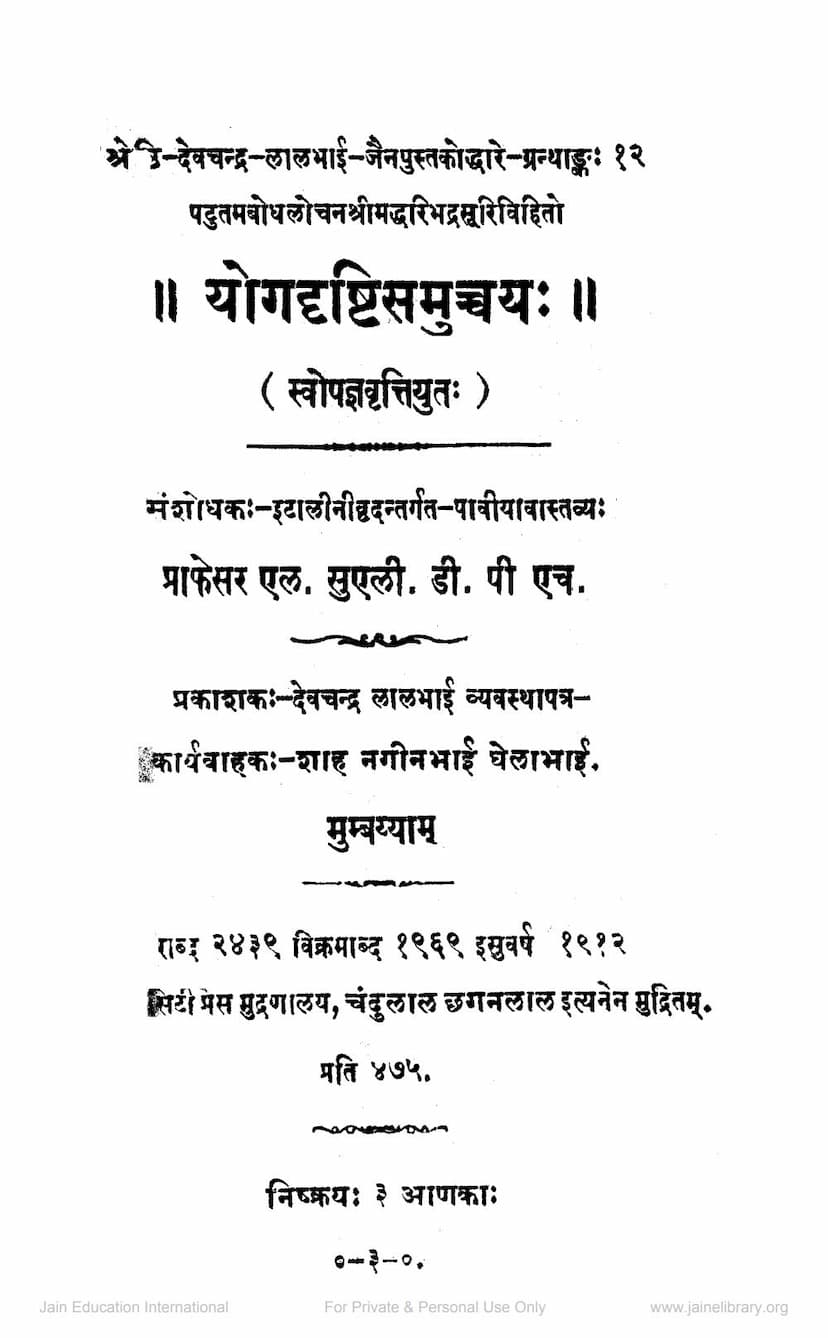Yogdrushti Samucchaya
Added to library: September 2, 2025

Summary
Here's a comprehensive summary of the Jain text "Yogdrushti Samucchaya" by Haribhadrasuri, based on the provided pages:
Book Title: Yogdrushti Samucchaya (योगदृष्टिसमुच्चयः) Author: Haribhadrasuri (श्रीमान् हरिभद्रसूरयः) Commentary: Swopajnya Vritti (स्वोपज्ञवृत्तियुतः) - written by Haribhadrasuri himself. Publisher: Devchand Lalbhai Pustakoddhar Fund (देवचन्द्र लालभाई व्यवस्थापत्रकार्यवाहकः) Publication Year: 1912 (विक्रमाब्द १९६९, इसुवर्ष १९१२)
Overview:
The Yogdrushti Samucchaya is a foundational Jain text on the philosophy and practice of Yoga, authored by the renowned Jain scholar and prolific writer, Haribhadrasuri. The book is presented with its own auto-commentary (Swopajnya Vritti), offering a deep and authoritative explanation of the concepts. The text aims to elucidate the eight types of "Yoga-drishti" (yogic perspectives or insights) that are central to understanding and achieving the Jain path to liberation.
Author and Context:
Haribhadrasuri is described as one of the most eminent Jain writers, flourishing in the sixth century of the Vikrama era (corresponding to the 5th or 6th century CE). The preface highlights that around sixty of his works are known, and this text is the twelfth in a series published by the Devchand Lalbhai Pustakoddhar Fund. The preface also mentions another commentary on this work by "Shri Sadhuraja Gani," which the publishers hoped to release later. The edition provided here was edited by Professor L. Suali, Ph.D., an Italian scholar of Sanskrit.
Core Philosophical Aim:
The Yogdrushti Samucchaya aims to provide a systematic understanding of Yoga within the Jain framework. It seeks to clarify the nature of Yoga, its various stages and perspectives, and how they contribute to spiritual progress and ultimately, liberation (Moksha). The text emphasizes the importance of correct understanding and practice, distinguishing genuine Yogic insights from mere intellectual speculation or misinterpretations.
Key Concepts and Structure:
-
Invocation and Purpose: The text begins with an invocation and outlines its purpose: to explain Yoga and its different "drishtis" (perspectives) for the benefit of yogis. It emphasizes the importance of respecting tradition (Shishta Samaya) and overcoming obstacles.
-
Classification of Yoga: The commentary introduces three primary types of Yoga:
- Ichha Yoga (इच्छायोग): Yoga driven by desire or aspiration, often characterized by imperfect or incomplete practice due to limitations of time, knowledge, or effort.
- Shastra Yoga (शास्त्रयोग): Yoga guided by scriptures, performed diligently according to scriptural injunctions, and characterized by correct understanding.
- Samarthya Yoga (सामर्थ्ययोग): The highest form of Yoga, achieved through the mastery of scriptural methods and the development of profound spiritual power and insight. This is considered the most excellent.
-
The Eight Yoga-drishtis: The central theme of the book is the exposition of eight distinct "Yoga-drishtis." These are described using metaphors of light and perception to illustrate different levels of spiritual understanding and practice:
- Mitra (मित्रा): Friend-like, the initial stage, characterized by limited or weak insight.
- Tara (तारा): Star-like, a slightly improved insight.
- Bala (बला): Strong, indicating a more robust understanding.
- Deepa (दीपा): Lamp-like, providing clear illumination.
- Sthira (स्थिरा): Steady, characterized by firm and unwavering insight, often associated with a deeper understanding of reality.
- Kanta (कान्ता): Beloved or attractive, indicating a deep affinity for the truth.
- Prabha (प्रभा): Radiance, a stage of heightened spiritual perception.
- Para (परा): Supreme or ultimate, representing the highest level of yogic insight.
These eight perspectives are characterized by the progressive overcoming of obscurations (aavarana-paya) and are compared to ascending stages of spiritual development, cultivated through ethical practices (Yama and Niyama), concentration, meditation, and ultimately, absorption (Samadhi).
-
Qualities of a Yogi: The text details the attributes and practices of a yogi at different stages. This includes:
- Overcoming Defilements: The importance of overcoming negative emotions like attachment, aversion, anger, pride, delusion, and greed.
- Ethical Conduct: Emphasis on practices like non-violence, truthfulness, non-stealing, celibacy, and non-possession (Yamas).
- Spiritual Knowledge: The crucial role of scriptural knowledge (Shruta) and right understanding (Samyakdarshana) in guiding yogic practice.
- Devotion and Respect: The significance of reverence towards spiritual teachers (Gurus), divine beings, and the scriptures.
- Detachment: The necessity of detachment from worldly pleasures and the cycle of birth and death (Bhava-viraga).
-
Distinguishing True Yoga: The book frequently contrasts true yogic understanding (often termed "Vedyam-Samvedyam" - that which is known and cognized appropriately) with illusory or misleading perspectives ("Avedyam-Samvedyam" - that which is wrongly perceived). This distinction is crucial for avoiding spiritual pitfalls and ensuring progress.
-
The Nature of Liberation (Moksha): The text defines liberation not merely as an absence of suffering but as a state of pure, unadulterated consciousness, free from the karmic cycle. It is the ultimate goal achieved through the mastery of Yoga and the eradication of all defilements.
-
Critique of Other Philosophies (Subtle References): While not explicitly named in the provided pages, the text implicitly critiques philosophical views that might misinterpret the nature of the soul, reality, or liberation. The emphasis on scriptural authority and correct inference suggests a dialogue with broader philosophical traditions.
-
The Role of Scriptures and Teachers: The text strongly upholds the authority of scriptures and the guidance of enlightened teachers (Gurus) as indispensable for true yogic attainment.
Significance:
The Yogdrushti Samucchaya is a valuable resource for understanding the sophisticated approach to Yoga within the Jain tradition. It offers a structured path for spiritual development, emphasizing the integration of ethical conduct, scriptural wisdom, and contemplative practices. Haribhadrasuri's work provides a clear framework for aspirants to navigate the complexities of spiritual practice and realize the ultimate goal of liberation.